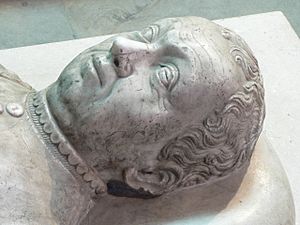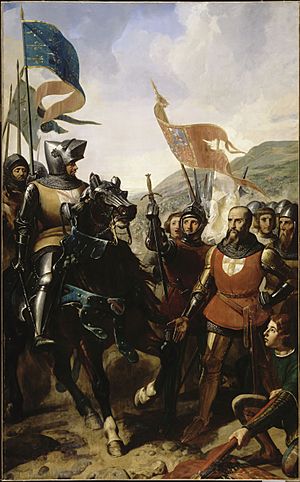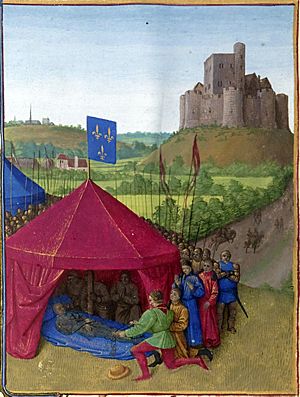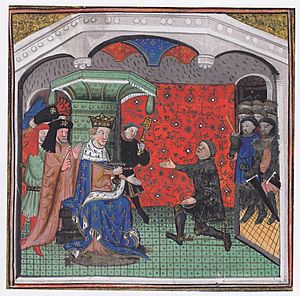Bertrand du Guesclin facts for kids
Quick facts for kids
Bertrand du Guesclin
|
|
|---|---|

Head detail of Bertrand du Guesclin's gisant in the Basilica of Saint-Denis, sculpted during the last quarter of the 14th century. The effigy was commissioned after du Guesclin's death by Charles V of France
|
|
| Born | c. 1320 Broons |
| Died | 13 July 1380 (aged c. 60) Châteauneuf-de-Randon |
| Buried | |
| Allegiance | |
| Rank | Constable of France |
| Conflicts Battles |
Hundred Years' War War of the Breton Succession Castilian Civil War Battle of Montmuran (1354) Battle of Cocherel (1364) Battle of Auray (1364) (POW) Battle of Nájera (1367) (POW) Battle of Montiel (1369) Battle of Pontvallain (1370) Battle of Chiset (1373) |
| Spouse(s) | Tiphaine Raguenel (1363 - 1373) |
Bertrand du Guesclin (born around 1320 – died July 13, 1380) was a famous Breton knight and a very important military leader for France during the Hundred Years' War. He was known by nicknames like "The Eagle of Brittany" and "The Black Dog of Brocéliande." From 1370 until he died, he was the Constable of France for King Charles V. This was the highest military job in France. He was good at using smart battle plans and won many important fights.
Contents
Early Life and Family
Bertrand du Guesclin was born in Broons, a place near Dinan in Brittany. He was the first son of Robert du Guesclin and Jeanne de Malmaines. We don't know his exact birthday, but it was likely around 1320. His family belonged to the lower nobility of Brittany.
Military Career
Fighting in Brittany

Bertrand du Guesclin first served Charles of Blois in the War of the Breton Succession. This war lasted from 1341 to 1364. Charles of Blois was supported by the French king. His rival, Jean de Montfort, was allied with England.
In 1354, Du Guesclin became a knight. He earned this honor after stopping an attack by an English knight named Hugh Calveley. In 1356 and 1357, Du Guesclin successfully defended the city of Rennes from a siege by English and Breton forces. He used smart, sneaky tactics, like guerrilla warfare, to fight the enemy. During this siege, he even won a duel against an English knight.
Du Guesclin's strong defense helped the French and Bretons feel more hopeful after a big French loss at the Battle of Poitiers. His bravery caught the attention of the French prince, Charles.
When Charles became King in 1364, he sent Du Guesclin to deal with Charles II of Navarre. Charles II wanted to take control of the Duchy of Burgundy, which King Charles V wanted for his own brother, Philip. On May 16, Du Guesclin led a French army against an English and Navarrese army. This battle was at Cocherel. Du Guesclin showed he was a great commander by completely defeating the enemy. This victory made Charles II of Navarre sign a new peace treaty with the French king. It also made sure Burgundy went to Philip.
However, on September 29, 1364, Charles of Blois's army was badly beaten at the Battle of Auray. This battle was against John IV, Duke of Brittany and English forces. Charles of Blois was killed, which ended his family's claim to Brittany. Du Guesclin fought bravely until his weapons broke, showing he had to surrender. He was captured and King Charles V paid a large sum of 100,000 francs to get him back. The King knew how valuable Du Guesclin was.
Adventures in Castile
In 1366, Bertrand du Guesclin convinced many "free companies" to join him. These were groups of soldiers who had been causing trouble in France after a peace treaty. He led them on a trip to Castile (a kingdom in Spain) to help Henry of Trastámara. Henry was fighting against Pedro I of Castile. In 1366, Du Guesclin and his trusted friend Guillaume Boitel captured many forts, including the capital city of Burgos.
After Henry was crowned king in Burgos, he made Bertrand du Guesclin his successor as Count of Trastámara. He even crowned him as King of Granada, though that kingdom was still controlled by others.
However, in 1367, Pedro's army, led by the famous English commander Edward, the Black Prince, defeated Henry's army at the Battle of Nájera. Du Guesclin was captured again. King Charles V once more paid a large ransom to free him. The English army suffered greatly in this campaign, and the Black Prince, who became sick, soon stopped supporting Pedro.
Du Guesclin and Henry of Trastámara attacked again. They defeated Pedro at the important Battle of Montiel in 1369. After the battle, Pedro ran to a castle. He secretly contacted Du Guesclin, offering him money to help him escape. Du Guesclin agreed, but he also told Henry about the plan. Henry promised Du Guesclin even more money and land if he would lead Pedro to Henry's tent.
Once Pedro was in Henry's tent, the two half-brothers started fighting with daggers. Pedro was about to win, but Du Guesclin, who had been watching, made a choice. He grabbed Pedro's ankle and flipped him over. This allowed Henry to stab Pedro and become the King of Castile. As he flipped Pedro, Du Guesclin is said to have said, "Ni quito ni pongo rey, pero ayudo a mi señor" (I neither remove nor put a King, but I do help my Sire). This phrase is still used in Spanish today.
After this, Bertrand was made Duke of Molina. This event also created a strong friendship between France and Castile.
Constable of France
War with England started again in 1369. King Charles V called Du Guesclin back from Castile in 1370. The King decided to make him Constable of France, which was the country's top military leader. Usually, this job went to a very important nobleman. But Charles needed someone who was an amazing professional soldier, even if Du Guesclin was not from a very high-ranking family. Du Guesclin often found it hard to get noble leaders to follow his orders. So, his armies were mostly made up of his own loyal soldiers. He officially became Constable on October 2, 1370.
He quickly defeated an English army at the Battle of Pontvallain. Then, he took back many French areas like Poitou and Saintonge. This forced the Black Prince to leave France.
In 1372, the combined French and Castilian fleet destroyed the English fleet at the Battle of La Rochelle. Over 400 English knights and 8,000 soldiers were captured. With control of the English Channel, Du Guesclin organized attacks on the English coast. These attacks were revenge for English raids on France.
Du Guesclin continued to chase the English into Brittany from 1370 to 1374. He defeated another English army at the Battle of Chizé in 1373.
He did not agree with King Charles V taking over Brittany in 1378. Because of this, his efforts to make the independent duchy submit to the French king were not very strong.
Death and Burial

Bertrand du Guesclin was a skilled planner and a very loyal soldier. He had taken back much of France from the English when he died from an illness in Châteauneuf-de-Randon. This happened during a military mission in Languedoc in 1380. He was buried at Saint-Denis in the tomb of the Kings of France. This tomb was later destroyed during the French Revolution. His heart is kept in the basilica of Saint-Sauveur in Dinan.
Legacy and Stories

Because Du Guesclin was so loyal to France, some Breton nationalists in the 20th century saw him as a "traitor" to Brittany. During World War II, a group that supported the Nazis destroyed a statue of him in Rennes. In 1977, another group, the Breton Liberation Front, destroyed a statue of him in Broons.
Bertrand du Guesclin appears as a character in Arthur Conan Doyle's historical novel The White Company, written in 1891. He is also a main character in a series of Dutch historical youth novels called Geef me de Ruimte by Thea Beckman.
See also
 In Spanish: Bertrand du Guesclin para niños
In Spanish: Bertrand du Guesclin para niños



